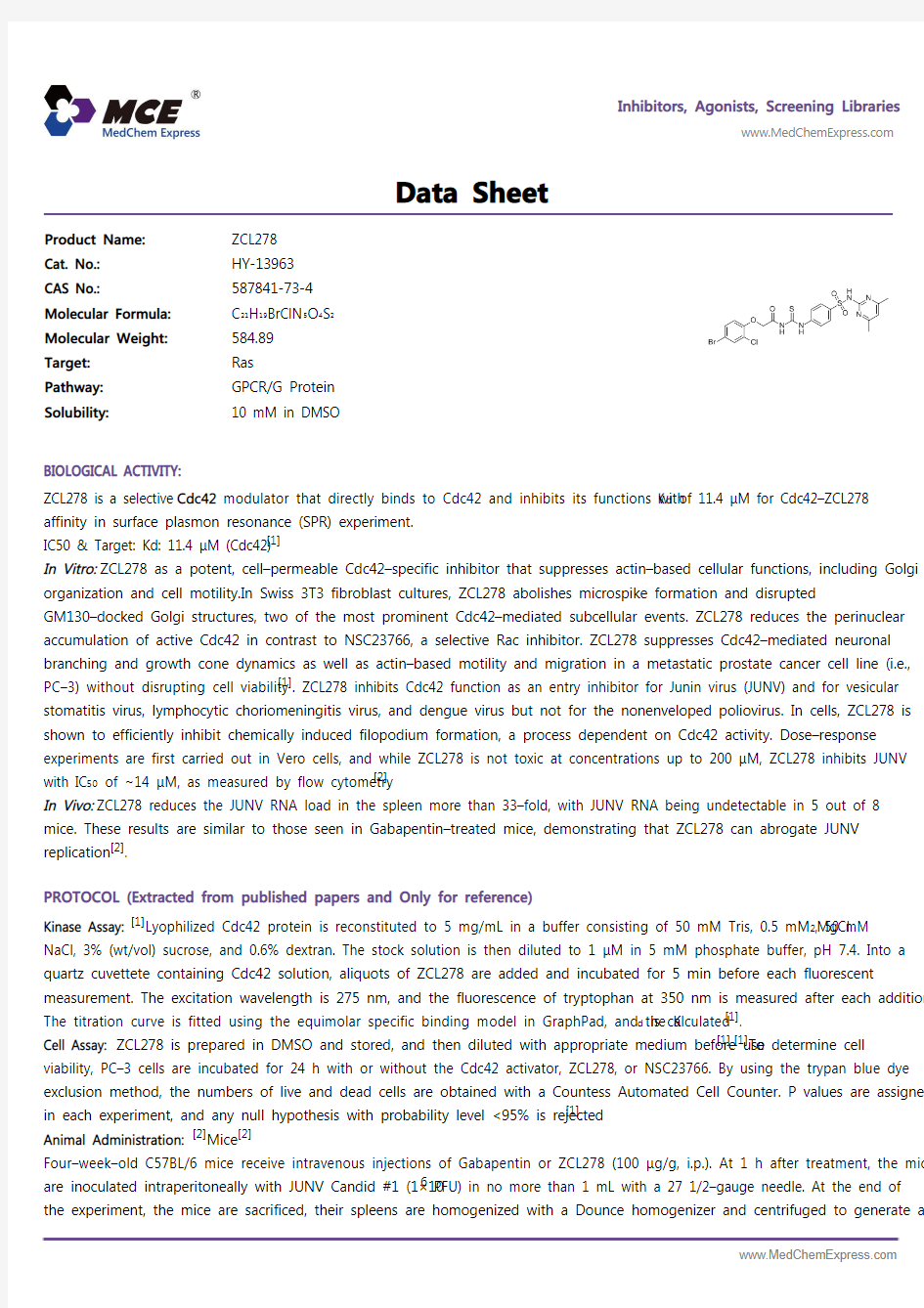ZCL278_DataSheet_MedChemExpress


Inhibitors, Agonists, Screening Libraries
https://www.wendangku.net/doc/ef1001320.html, Data Sheet
BIOLOGICAL ACTIVITY:
ZCL278 is a selective Cdc42 modulator that directly binds to Cdc42 and inhibits its functions with K d of 11.4 μM for Cdc42–ZCL278affinity in surface plasmon resonance (SPR) experiment.
IC50 & Target: Kd: 11.4 μM (Cdc42)[1]
In Vitro: ZCL278 as a potent, cell–permeable Cdc42–specific inhibitor that suppresses actin–based cellular functions, including Golgi organization and cell motility.In Swiss 3T3 fibroblast cultures, ZCL278 abolishes microspike formation and disrupted
GM130–docked Golgi structures, two of the most prominent Cdc42–mediated subcellular events. ZCL278 reduces the perinuclear accumulation of active Cdc42 in contrast to NSC23766, a selective Rac inhibitor. ZCL278 suppresses Cdc42–mediated neuronal branching and growth cone dynamics as well as actin–based motility and migration in a metastatic prostate cancer cell line (i.e.,PC–3) without disrupting cell viability [1]. ZCL278 inhibits Cdc42 function as an entry inhibitor for Junin virus (JUNV) and for vesicular stomatitis virus, lymphocytic choriomeningitis virus, and dengue virus but not for the nonenveloped poliovirus. In cells, ZCL278 is shown to efficiently inhibit chemically induced filopodium formation, a process dependent on Cdc42 activity. Dose–response
experiments are first carried out in Vero cells, and while ZCL278 is not toxic at concentrations up to 200 μM, ZCL278 inhibits JUNV with IC 50 of ~14 μM, as measured by flow cytometry [2].
In Vivo: ZCL278 reduces the JUNV RNA load in the spleen more than 33–fold, with JUNV RNA being undetectable in 5 out of 8mice. These results are similar to those seen in Gabapentin–treated mice, demonstrating that ZCL278 can abrogate JUNV
replication [2].
PROTOCOL (Extracted from published papers and Only for reference)
Kinase Assay:[1]Lyophilized Cdc42 protein is reconstituted to 5 mg/mL in a buffer consisting of 50 mM Tris, 0.5 mM MgCl 2, 50 mM NaCl, 3% (wt/vol) sucrose, and 0.6% dextran. The stock solution is then diluted to 1 μM in 5 mM phosphate buffer, pH 7.4. Into a quartz cuvettete containing Cdc42 solution, aliquots of ZCL278 are added and incubated for 5 min before each fluorescent
measurement. The excitation wavelength is 275 nm, and the fluorescence of tryptophan at 350 nm is measured after each addition.The titration curve is fitted using the equimolar specific binding model in GraphPad, and the K d is calculated [1].
Cell Assay: ZCL278 is prepared in DMSO and stored, and then diluted with appropriate medium before use [1].[1]To determine cell viability, PC–3 cells are incubated for 24 h with or without the Cdc42 activator, ZCL278, or NSC23766. By using the trypan blue dye exclusion method, the numbers of live and dead cells are obtained with a Countess Automated Cell Counter. P values are assigned in each experiment, and any null hypothesis with probability level <95% is rejected [1].
Animal Administration:[2]Mice [2]
Four–week–old C57BL/6 mice receive intravenous injections of Gabapentin or ZCL278 (100 μg/g, i.p.). At 1 h after treatment, the mice are inoculated intraperitoneally with JUNV Candid #1 (1×106 PFU) in no more than 1 mL with a 27 1/2–gauge needle. At the end of the experiment, the mice are sacrificed, their spleens are homogenized with a Dounce homogenizer and centrifuged to generate a cell
Product Name:
ZCL278Cat. No.:
HY-13963CAS No.:
587841-73-4Molecular Formula:
C 21H 19BrClN 5O 4S 2Molecular Weight:
584.89Target:
Ras Pathway:
GPCR/G Protein Solubility:
10 mM in DMSO
pellet and supernatant, and RNA expression levels are determined.
References:
[1]. Friesland A, et al. Small molecule targeting Cdc42–intersectin interaction disrupts Golgi organization and suppresses cell motility. Proc Natl Acad Sci U S
A. 2013 Jan 22;110(4):1261–6.
[2]. Chou YY, et al. Identification and Characterization of a Novel Broad–Spectrum Virus Entry Inhibitor. J Virol. 2016 Apr 14;90(9):4494–510.
Caution: Product has not been fully validated for medical applications. For research use only.
Tel: 609-228-6898 Fax: 609-228-5909 E-mail: tech@https://www.wendangku.net/doc/ef1001320.html,
Address: 1 Deer Park Dr, Suite Q, Monmouth Junction, NJ 08852, USA
